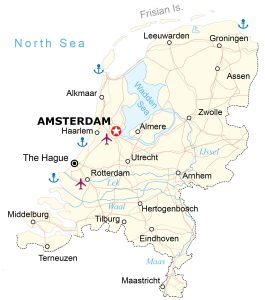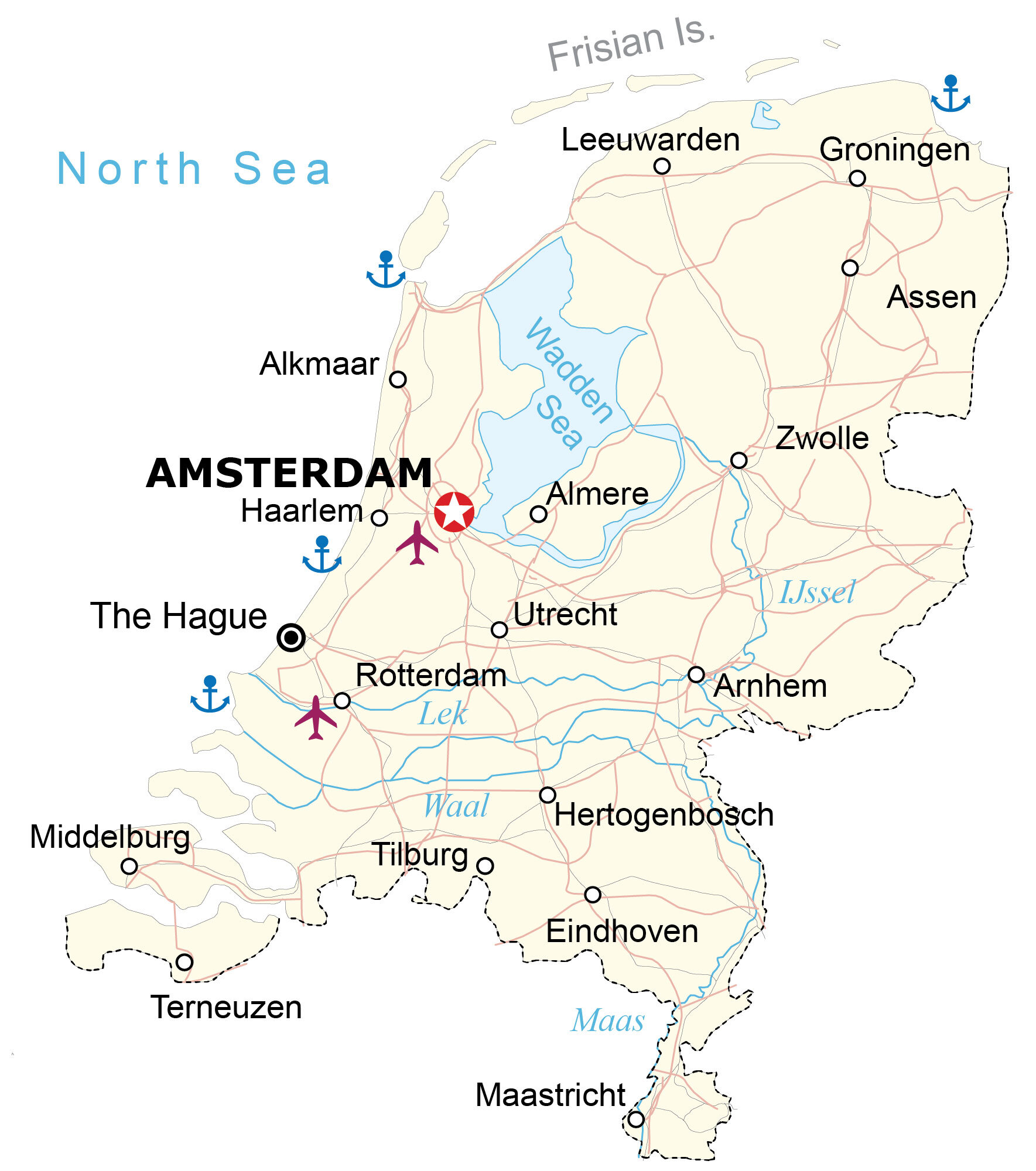 Explore the top 7 major ports in the Netherlands, including Rotterdam, Amsterdam, and Groningen Seaports. Discover their roles in global trade, sustainability, and innovation, with insights into cargo volumes, energy hubs, and cruise tourism.
Explore the top 7 major ports in the Netherlands, including Rotterdam, Amsterdam, and Groningen Seaports. Discover their roles in global trade, sustainability, and innovation, with insights into cargo volumes, energy hubs, and cruise tourism.
When people think of the Netherlands, canals, windmills, and tulip fields often come to mind. Yet, the country’s identity is just as strongly tied to the sea. As a low-lying nation with centuries of maritime tradition, the Netherlands has built some of the world’s most advanced and busiest ports. These ports are not just Dutch infrastructure—they are European gateways, serving as arteries of global commerce.
According to UNCTAD (2023), the Netherlands consistently ranks among the top 10 global trading nations, largely thanks to its ports. Together, Dutch ports handle over 600 million tonnes of cargo annually, including containers, crude oil, LNG, chemicals, and agricultural products. The ports also play a central role in the European Union’s TEN-T network, linking global supply chains with inland waterway and rail corridors across the continent.
In this article, we examine the top 7 major ports in the Netherlands, highlighting their economic power, innovative technologies, and their place in the world’s maritime future.
–
Why Dutch Ports Matter in Modern Maritime Operations
The Netherlands has a unique geographic advantage. Its coastline opens into the North Sea, one of the busiest shipping lanes in the world, while its river systems (notably the Rhine and Maas) link deep-sea ports with the industrial heart of Europe, including Germany, Switzerland, and France. Dutch ports matter because they:
- Serve as Europe’s trade gateway – Rotterdam alone accounts for nearly 14% of EU seaport throughput (Eurostat, 2022).
- Enable energy security – with major crude oil, LNG, and renewable energy hubs.
- Lead in innovation – investing in green hydrogen, digital twins, and autonomous vessels.
- Boost employment – the Dutch port sector supports over 385,000 jobs directly and indirectly (Port of Rotterdam Authority, 2023).
–
The Top 7 Major Ports in the Netherlands
Port of Rotterdam – Europe’s Maritime Giant
The Port of Rotterdam is not only the largest port in the Netherlands but also the biggest in Europe. Spanning over 12,500 hectares, it stretches 40 km along the Maas River into the North Sea.
-
Throughput: In 2022, Rotterdam handled 467 million tonnes of cargo, including containers, crude oil, LNG, coal, and agricultural products.
-
Global Role: Rotterdam is often called “Europe’s Gateway”, connecting 1,000 ports worldwide. Its deep-water berths accommodate the largest container vessels (24,000 TEU+).
-
Innovation: The port is pioneering digital twin technologies, smart logistics systems, and a hydrogen hub strategy to support the EU’s net-zero targets by 2050.
-
Energy Transition: Home to major oil refineries and LNG terminals, Rotterdam is shifting toward renewable energy imports and offshore wind assembly bases.
Rotterdam embodies Dutch resilience: a port built below sea level, safeguarded by advanced dikes, yet shaping global trade every single day.
Port of Amsterdam – Energy and Bulk Commodities Powerhouse
Amsterdam, the second-largest Dutch port, is famous not only for its historic canals but also as a leading European hub for energy and bulk cargo.
-
Throughput: The port handles 72 million tonnes annually, with strengths in liquid bulk (oil products, chemicals), agribulk, and breakbulk.
-
Energy Role: Amsterdam is Europe’s largest gasoline port and a critical node for energy security.
-
Sustainability: It has ambitious plans to become a green energy port, focusing on hydrogen imports, circular economy logistics, and offshore wind servicing.
The port also welcomes cruise ships, linking tourism with trade. Its dual identity—historic and modern—makes Amsterdam unique among Dutch ports.
North Sea Port (Vlissingen, Terneuzen, Ghent) – Cross-Border Strength
North Sea Port is a binational seaport, stretching across southern Netherlands (Vlissingen and Terneuzen) and Belgium (Ghent). Formed in 2018, it is one of Europe’s largest industrial port complexes.
-
Throughput: Roughly 70 million tonnes of cargo annually.
-
Industrial Power: Hosts major industries in steel (ArcelorMittal), automotive, chemicals, and energy.
-
Inland Links: Excellent access to the Rhine-Scheldt Canal, providing seamless barge and rail connections deep into Europe.
North Sea Port demonstrates how Dutch ports embrace cross-border cooperation, creating resilience and scale in the global supply chain.
Groningen Seaports (Delfzijl and Eemshaven) – Renewable Energy Frontiers
Located in the northern Netherlands, Groningen Seaports include Delfzijl and Eemshaven, both playing strategic roles.
-
Throughput: Around 11 million tonnes annually, with emphasis on bulk commodities, biomass, and industrial goods.
-
Energy Role: Eemshaven has become a hub for offshore wind energy assembly and maintenance, supporting projects in the North Sea.
-
Innovation: Groningen Seaports are leading in hydrogen economy projects, connecting renewable generation with industry.
Though smaller in scale, Groningen Seaports are critical to the Netherlands’ energy transition strategy.
Port of Moerdijk – Industrial and Short-Sea Shipping Hub
Situated between Rotterdam and Antwerp, the Port of Moerdijk is the fourth-largest Dutch port by throughput.
-
Throughput: Handles 17 million tonnes of cargo annually.
-
Specialisation: Known for short-sea shipping, container logistics, and strong ties to the chemical and agro-industrial sectors.
-
Sustainability: Moerdijk is building circular economy clusters, focusing on waste recycling and bio-based industries.
Its location and multimodal links make Moerdijk a vital relief port, easing pressure on Rotterdam.
Port of Dordrecht – Specialist Bulk Cargo Port
As part of the Port of Rotterdam Authority, Dordrecht is the furthest inland seaport in the Netherlands.
-
Throughput: Around 4 million tonnes annually, specialising in bulk cargo.
-
Location Advantage: Direct access to the Rhine River makes it an efficient node for inland waterway transport to Germany and beyond.
-
Niche Role: Though smaller, it plays a complementary role in serving regional industries.
Port of Harlingen – Friesland’s Maritime Lifeline
Located in the northern province of Friesland, Harlingen is the largest seaport in the region and an essential hub for fisheries, short-sea shipping, and offshore logistics.
-
Throughput: Handles roughly 2–3 million tonnes annually, including agribulk, construction materials, and project cargo.
-
Fishing Industry: A leading base for Dutch fishing fleets.
-
Offshore Role: Increasingly supporting offshore wind construction in the North Sea.
Harlingen embodies the local, people-centred side of Dutch maritime life, balancing trade with cultural heritage.
Challenges Facing Dutch Ports
Like other European maritime hubs, Dutch ports face evolving challenges:
-
Decarbonisation: Meeting IMO 2050 and EU Fit-for-55 climate targets requires heavy investment in green fuels and shore power.
-
Geopolitical Risks: Supply chain shifts due to the Ukraine war and Red Sea tensions test port resilience.
-
Infrastructure Pressures: Increasing vessel sizes demand deeper berths, larger cranes, and digitalised traffic control.
-
Environmental Balance: Balancing economic growth with North Sea biodiversity protection is an ongoing debate.
Future Outlook: Smart, Green, and Resilient
The Netherlands is positioning itself as a leader in smart and green port development. Recent investments include:
-
Hydrogen Import Terminals: Rotterdam, Amsterdam, and Groningen Seaports are racing to become Europe’s hydrogen gateways.
-
Digital Innovation: Blockchain-based customs clearance and AI-driven traffic optimisation are being deployed.
-
Offshore Energy: Dutch ports are essential to Europe’s offshore wind expansion, projected to supply 300 GW by 2050 (European Commission).
The Port of Rotterdam Authority’s “Energy Transition Strategy” and the government’s Maritime Master Plan underline that Dutch ports are not only gateways of trade but also laboratories for sustainability.
FAQs
Which is the largest port in the Netherlands?
The Port of Rotterdam is the largest, handling nearly 470 million tonnes of cargo annually.
How do Dutch ports connect to Europe?
Through the Rhine, Maas, and Scheldt river systems, Dutch ports link seamlessly to Germany, Switzerland, and France by barge and rail.
Are Dutch ports investing in green energy?
Yes. Major projects in hydrogen, offshore wind, and circular economy clusters are underway in Rotterdam, Amsterdam, and Groningen Seaports.
What makes North Sea Port unique?
It is a cross-border port spanning the Netherlands and Belgium, integrating industries and logistics.
Which Dutch port is most important for fisheries?
The Port of Harlingen is a leading hub for Dutch fishing fleets and related industries.
Conclusion
The top 7 major ports in the Netherlands show how a small nation has leveraged geography, engineering, and innovation to become a global maritime leader. From the colossal scale of Rotterdam to the renewable energy frontiers of Groningen, Dutch ports are shaping the future of sustainable shipping and European trade.
For maritime students, professionals, and enthusiasts, the Netherlands provides a living laboratory where tradition meets innovation. The lesson is clear: ports are not just docking points—they are lifelines of the global economy, and the Netherlands has mastered the art of keeping those lifelines open, green, and resilient.

